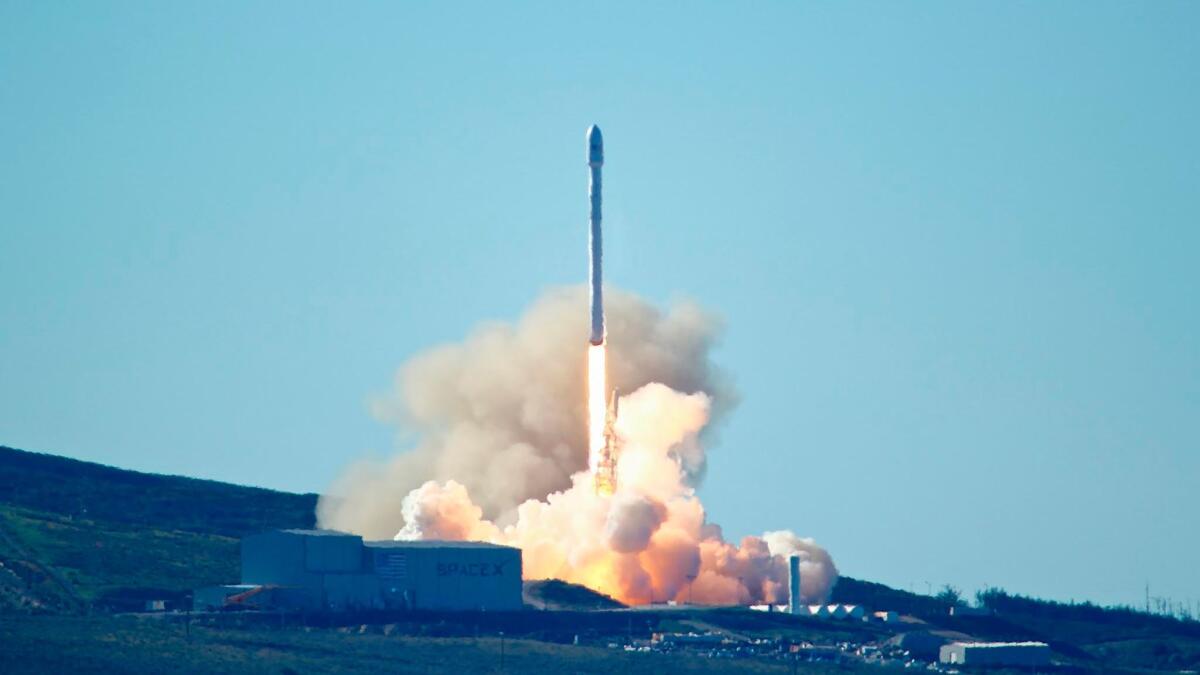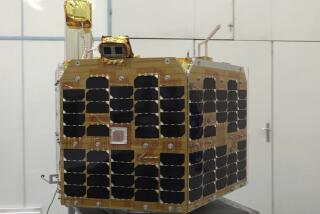SpaceX sends 10 satellites into orbit, lands rocket booster on drone ship in first flight since September explosion

Four months after a launch pad explosion, SpaceX returned to flight Saturday morning, delivering 10 satellites into orbit and landing its first-stage booster on a floating drone ship.
Analysts had described the launch as “all-important” for the Hawthorne space company to reestablish customer confidence and momentum after a Sept. 1 launchpad explosion in Florida destroyed a Falcon 9 rocket and a commercial communications satellite perched on top. But beyond the specter of the accident, stakes were high for Saturday’s launch because it involved deploying the first 10 satellites of a new commercial constellation for well-known operator Iridium Communications Inc.
The new satellites have more capability than their older counterparts, including higher data speeds. Saturday’s launch is the first of seven that SpaceX will perform for Iridium to carry a total of 70 satellites into orbit.
“There was a lot riding on this for SpaceX, but also for Iridium, and I think they can breathe a sigh of relief,” said Marco Caceres, senior space analyst at the Teal Group.
The launch occurred at 9:54 a.m. Pacific time from Vandenberg Air Force Base, north of Santa Barbara. About eight minutes after liftoff, the first-stage rocket booster landed upright on a floating platform called “Just Read the Instructions” in the Pacific Ocean.
About an hour after the launch, company Chief Executive Elon Musk tweeted that the mission “looks good.” By 11:15 a.m., Musk tweeted that all satellites had been successfully delivered to the correct orbit.
The launch comes after an investigation into the September explosion that was led by SpaceX and assisted by the U.S. Air Force, NASA, the National Transportation Safety Board and industry experts, with oversight from the Federal Aviation Administration. The investigation concluded last week that the cause was the failure of a pressure vessel that stores cold helium to maintain pressure in the liquid oxygen tank.
The company said the failure of one of three such tanks, inside the rocket’s larger, second-stage liquid oxygen tank, probably occurred after a buildup of liquid oxygen between the vessel’s aluminum inner liner and its carbon overwrap ignited.
The FAA said last week that it accepted the accident report and closed the investigation.
SpaceX said it would change the configuration of the vessels and change helium loading operations.
Every mission until about 2018 will be watched closely, as SpaceX and Boeing Co. are both contracted to build capsules to transport astronauts to the International Space Station.
NASA has said that the first uncrewed flight of SpaceX’s spacecraft is set for November, and its first flight test with humans aboard is scheduled for May 2018.
“Every mission will be crucial,” Caceres said. “But this one was particularly crucial because you don’t want two failures in a row. So I think this was a huge success.”
For more business news, follow me @smasunaga
MORE BUSINESS NEWS
Two big Snapchat updates make the app work more like Facebook, Instagram or Twitter
France investigating Renault on suspicion of emissions fraud
Trump meets with AT&T chief amid his battle with CNN and opposition to Time Warner deal
With sale to Canadian firm, American Apparel will be American no longer
UPDATES:
Jan. 14, 11:45 a.m.: This article was updated with the successful deployment of the satellites and analysis of implications of the launch.
Jan. 14, 10:30 a.m.: This article was updated with details about the launch and first-stage rocket booster landing.
This article was originally published on Jan. 13 at 7:55 a.m.
More to Read
Inside the business of entertainment
The Wide Shot brings you news, analysis and insights on everything from streaming wars to production — and what it all means for the future.
You may occasionally receive promotional content from the Los Angeles Times.











